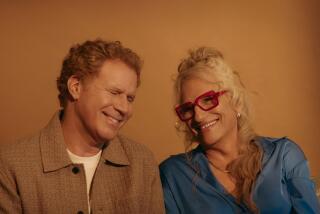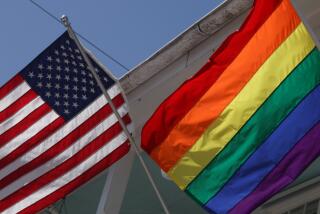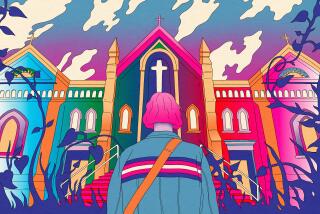‘Steven Universe’ changed TV forever. For its creator, its queer themes were personal
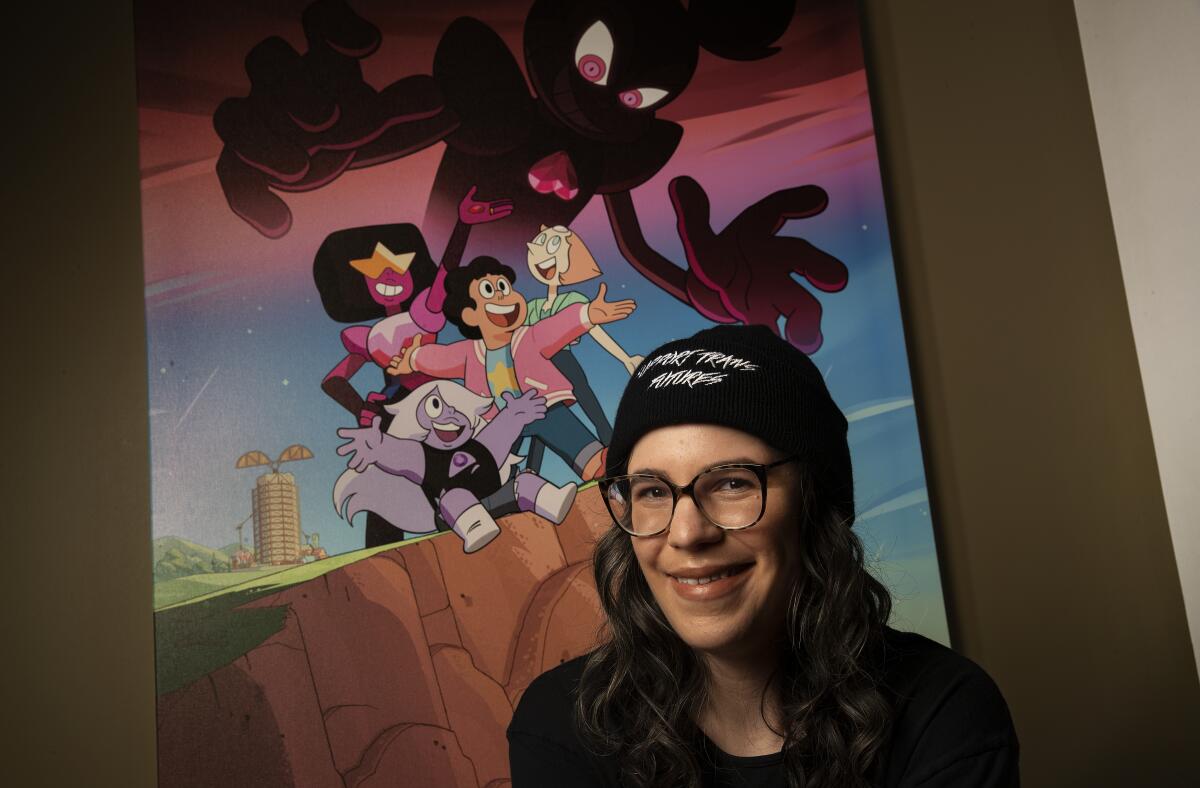
When “Steven Universe” debuted in 2013, it introduced the world to a charming, cheerful boy who is just learning how to be a hero. It’s quickly apparent that the half-human, half-magical teen loves his friends and family, is enthusiastic about food and is eager to prove that he’s ready to save the world.
Guiding Steven (voiced by Zach Callison) along his journey are Garnet (Estelle), Amethyst (Michaela Dietz) and Pearl (Deedee Magno Hall) — a team of extraterrestrial beings known as the Crystal Gems who have sworn to protect Earth.
Over the course of five seasons, Steven and the Crystal Gems face innumerable, increasingly powerful threats and learn uncomfortable truths about the past. But it’s the characters and their relationships that are central to the show.
“My goal from the very beginning of ‘Steven Universe’ was to tell a very personal story,” said creator and showrunner Rebecca Sugar on an early March morning at Cartoon Network Studios in Burbank. The long-running show is based on Sugar’s relationship with her brother, Steven.
The main series wrapped in 2019 after Steven helped establish peace across the universe, but his story wasn’t over; a TV movie picking up two years after the end of the show aired later that year. Steven’s story was further extended into a limited epilogue series, “Steven Universe Future,” which concludes with a four-part series finale airing Friday.
A whimsical, musical coming-of-age story, the five-time Emmy-nominated series became known for thoughtfully engaging with themes not often addressed in children’s television: trauma, grief, toxic relationships, consent, empathy and more.
But “Steven Universe’s” greatest legacy is repeatedly breaking new ground for LGBTQ representation in kids’ cartoons. Not only does the fantasy/sci-fi series include a range of recognizably queer and nonbinary characters, it has also featured a same-sex proposal and wedding.
This inclusive storytelling has resonated with fans and is among the reasons “Steven Universe” has been hailed by critics. The show has earned both a GLAAD Media Award and a Peabody.
As Cartoon Network’s chief content officer Rob Sorcher says, “Steven Universe” is the “gold standard” for the studio.
“This is the kind of content that we want to make,” Sorcher said. “We want to be working on things every day that’s going to actually matter in a young person’s life.”
He added: “The real legacy of this show is that it included such a wide spectrum of themes that were not ever really addressed in a realistic way on children’s television [before].”
The series stood out in its earliest days by defying expectations about what constitutes a “boy show” or a “girl show”: Its boy protagonist looks up to, and trains to be part of, a team of magical warrior women. But it wasn’t until the Season 1 finale, which aired in 2015, that the extent of the show’s queer representation became apparent.
“Jail Break” revealed to Steven and the audience that Garnet was in fact the fusion of Ruby (Charlyne Yi) and Sapphire (Erica Luttrell) and the personification of their romantic relationship.
“From the very beginning, one of my main goals was to find a way to create an interracial, queer-coded relationship that a whole generation of kids would see,” said Sugar, who identifies as nonbinary and uses both she/her and they/them pronouns. (“I don’t have to pick one. That’s the thing that’s so exciting,” Sugar said.)
The Gems in “Steven Universe” are also nonbinary women — they are coded female and are referred to by feminine pronouns but are biologically sexless, as a Gem’s form is actually the physical manifestation of the magic in the respective gemstone. This means relationships among Gems are coded queer too.
Gems’ ability to fuse expanded the possibilities for representation: One fusion represents a polyamorous relationship; another is intersex and nonbinary. But Ruby and Sapphire’s love story is something special.
It turns out that Garnet is unlike the fusions deemed “acceptable” by the rigid Gem Homeworld: She is a fusion of two types of Gems, who are fused simply because they want to be together.
For Sugar, this story line is especially personal. Ruby and Sapphire are based on her and her husband, “OK K.O.! Let’s Be Heroes” creator Ian Jones-Quartey.
Sugar’s commitment to getting Ruby and Sapphire’s story on TV stemmed from her firsthand understanding of how harmful it can be for queer youths to not see their experiences reflected in media. She also knew that being queer can put one in danger.
“When when I was 22, I was the target of a racist, homophobic assault,” said Sugar, detailing a night out walking with Jones-Quartey. “Ian is black and I am nonbinary, and at the time I had short hair and I wore very masculine clothes, so we were often perceived as two men.”
Because they got away, it was an incident they didn’t speak about for years. It wasn’t until she was working on “Steven Universe” that Sugar was able to understand that she had never properly dealt with the trauma — one of the central themes explored in “Steven Universe Future.”
This experience motivated her to craft a story in which, through understanding and rooting for Garnet — a queer-coded, interracial relationship — “a whole generation of kids could root for us [and] could see us walking down the street, holding hands and never think to do something like that to us because they would know that we don’t deserve [to be attacked].”
But it wasn’t easy.
“As I’m writing about this, as I’m pitching this, I’m also getting a lot of pushback,” Sugar said. “This was not considered acceptable material for children at the time. … [But] who is speaking to a generation of children about why they deserve to exist? About how they deserve to exist? I wanted to be able to do that.”
While working on “Jail Break” in 2014, “it became clear to the network that I was incorporating LGBTQIA+ characters and themes into the show,” Sugar said. She was told that there was a chance the show could be canceled if authorities in conservative countries noticed and objected to those themes.
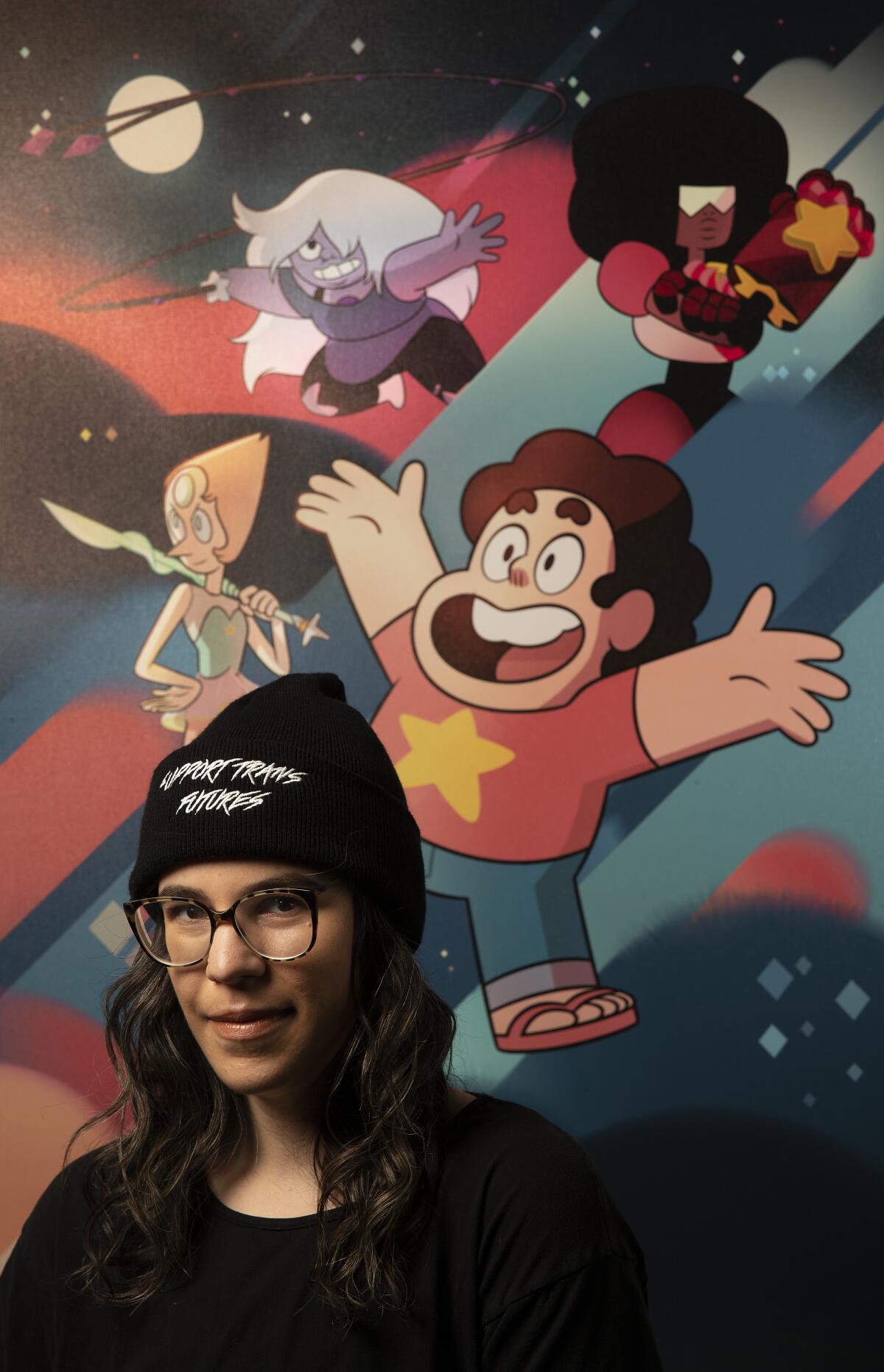
“My biggest concern at the time was that I didn’t want the show to disappear in these countries where I was very worried about the kids there,” Sugar said.
So she avoided directly addressing certain questions about the show’s queer representation, both to navigate the situation with the international market and because, at the time, she was not yet out to her family. Instead, she focused on expressing herself through the cartoon.
“That just became unsustainable,” said Sugar. “By late 2015 and 2016, it was just too painful to not be open about it.”
Sugar came out as bisexual during the “Steven Universe” panel at San Diego Comic-Con in 2016 and has become increasingly vocal about the need for LGBTQ narratives in children’s television. She has also addressed how biphobic attitudes she encountered when she was younger had erased the idea of bisexuality as an authentic identity.
“I don’t know if I had been totally ready in that moment,” Sugar said, recalling the audience Q&A in a capacity crowd ballroom that led to her coming out. “I just felt so bad. I was just so tired of giving vague answers to this.”
It was later that year that Sugar and her team finally got the go-ahead for Ruby and Sapphire’s wedding.
Though the Season 5 episode didn’t air until 2018, it was something Sugar had been trying to get made since 2015 — the culmination of all the groundwork she had laid over the course of the series.
Whenever the network pushed back on episodes, Sugar “would leave and strategize how to make the most engaging, entertaining, undeniably sweet, wonderful thing that nobody in their right mind could say would not be great to see on television.” And she trusted her crew to be able to pull it off.
“Showing the fantasy elements of [Ruby and Sapphire’s] relationship was easier to get through than them just playing baseball together and saying ‘I want to look at you,’ or them them laughing together and wanting to be together,” Sugar said. “The relatable human interactions, that was more trouble, which was surprising. But it was also really interesting that this is what children can’t see — something as simple as the small human interactions between two people in love.”
For the wedding episode, Sugar wouldn’t bend: Her approach to network notes was to add more. Previous episodes showed why it was absolutely in character for Ruby, Sapphire and even Steven to want this wedding. She even included a massive musical number and a giant robot fight to counter any argument that 6- to 11-year-old boys would not find the episode entertaining.
Ruby and Sapphire’s nuptials were the first same-sex wedding featured in a Cartoon Network series — complete with a kiss. It changed everything.
“It was at that time [when the episode received the go-ahead from the network] that the final decision was made that we would no longer be getting bigoted notes,” Sugar said. “That everything that a heteronormative couple could do on the show, this queer couple could do. That was it. And it also applied to every other [Cartoon Network] show.”
Sorcher credits Sugar for pushing for the change.
“Rebecca’s passion for real representation on the screen, the identification of queer characters in narratives for children, did educate me, because she really, deeply felt the importance of that,” Sorcher said. “I think her notion of radical inclusion really jump-started me and others forward.”
He added: “The idea that children’s programming can contain a wider spectrum of ideas and characters and stories, I think Rebecca Sugar broke that open and changed that forever.”
Of course, these changes did not happen in a vacuum. Attitudes and policies around the LGBTQ community have evolved since “Steven Universe’s” debut, including the recognition that same-sex marriage is a constitutional right.
Sugar stressed that it’s important to stay aware of the current political climate, which has seen states such as Idaho moving to enact anti-trans legislation, along with other efforts at the state and federal level to roll back LGBTQ rights. History has shown progress is not linear.
And when it comes to facing challenges political and personal, Sugar has always found comfort in returning to “Steven Universe’s” reason for being: its viewers.
“It’s funny, because the thing that was difficult about it — making something for kids — was the same thing that was keeping me grounded about it,” Sugar said.
“These prejudices are all learned. I was so glad to be making something for a young audience because they didn’t know that these things weren’t supposed to be in there.”
More to Read
The complete guide to home viewing
Get Screen Gab for everything about the TV shows and streaming movies everyone’s talking about.
You may occasionally receive promotional content from the Los Angeles Times.
